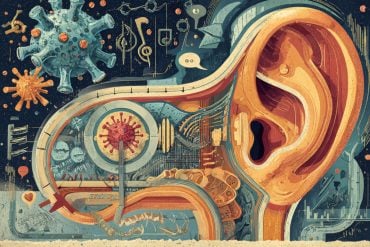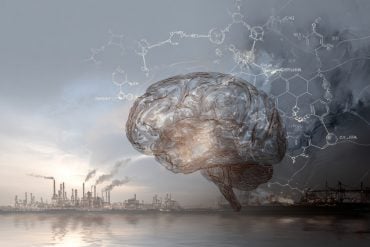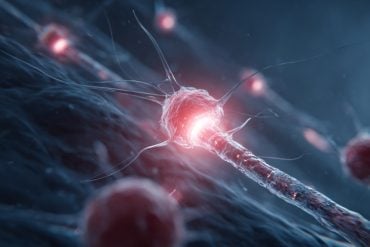Summary: Heavy drinking during adolescence negatively impacts brain development and growth. Chronic alcohol exposure reduces cerebral white matter and the development of the subcortical thalamus.
Source: Oregon Health and Science University
Heavy use of alcohol among adolescents and young adults is not only dangerous in its own right, but new research in nonhuman primates shows that it can actually slow the rate of growth in developing brains.
The study, published today in the journal eNeuro, shows that heavy alcohol use reduced the rate of brain growth by 0.25 milliliters per year for every gram of alcohol consumed per kilogram of body weight. In human terms, that’s the equivalent of four beers per day. The research involved rhesus macaque monkeys at the Oregon National Primate Research Center.
“Chronic alcohol self-intoxication reduced the growth rate of brain, cerebral white matter, and subcortical thalamus,” the researchers write.
Researchers measured brain growth through magnetic resonance imaging of 71 rhesus macaques that voluntarily consumed ethanol or beverage alcohol. Scientists precisely measured intake, diet, daily schedules, and health care, thus ruling out other factors that tend to confound results in observational studies involving people. The findings in the study helps validate previous research examining the effect of alcohol use on brain development in people.
“Human studies are based on self-reporting of underage drinkers,” said co-author Christopher Kroenke, Ph.D., an associate professor in the Division of Neuroscience at the primate center. “Our measures pinpoint alcohol drinking with the impaired brain growth.”
The new study is the first to characterize normal brain growth of 1 milliliter per 1.87 years in rhesus macaques in late adolescence and early adulthood. And it further reveals a decrease in the volume of distinct brain areas due to voluntary consumption of ethanol.
Lead author Tatiana Shnitko, Ph.D., a research assistant professor in the Division of Neuroscience at the primate center, said previous research has shown the brain has a capacity to recover at least in part following the cessation of alcohol intake. However, it’s not clear whether there would be long-term effects on mental functions as the adolescent and young adult brain ends its growth phase. The next stage of research will explore that question.

“This is the age range when the brain is being fine-tuned to fit adult responsibilities,” Shnitko said. “The question is, does alcohol exposure during this age range alter the lifetime learning ability of individuals?”
Funding: This study was funded by the National Institute on Alcohol Abuse and Alcoholism (U01 AA013510, P60 AA013510 and U24 AA025473.
Source:
Oregon Health and Science University
Media Contacts:
Erik Robinson – Oregon Health and Science University
Image Source:
The image is in the public domain.
Original Research: Closed access
“Chronic alcohol drinking slows brain development in adolescent and young adult non-human primates”
Tatiana A. Shnitko, Zheng Liu, Xiaojie Wang, Kathleen A. Grant and Christopher D. Kroenke. eNeuro 1 April 2019, ENEURO.0044-19.2019, doi:10.1523/ENEURO.0044-19.2019
Abstract
Chronic alcohol drinking slows brain development in adolescent and young adult non-human primates
The transition from adolescence to adulthood is associated with brain remodeling in the final stages of developmental growth. It is also a period when a large proportion of this age group engages to binge (occasional consumption of 4-5 drinks leading to intoxication) and heavy (binge drinking on ≥5 days in a month) alcohol drinking. Here we report on magnetic resonance imaging of developmental changes in the brain occurring during late adolescence and early adulthood (3.5-7.5 years) in a rhesus macaque model of alcohol self-administration. Monkeys were imaged prior to alcohol exposure, and following ∼6 and ∼12 months of daily (22 hr/day) access to ethanol and water. The results revealed that the brain volume increases by 1 ml per 1.87 years throughout the late adolescence and early adulthood in controls. Heavy alcohol reduced the rate of brain growth by 0.25 ml/year per 1 g/kg of daily ethanol. Cortical volume increased throughout this period with no significant effect of alcohol drinking on the cortical growth rate. In subcortical regions, age-dependent increases in the volumes of globus pallidus, thalamus, brainstem and cerebellum were observed. Heavy drinking attenuated the growth rate of the thalamus. Thus, developmental brain volume changes in the span of late adolescence to young adulthood in macaques is altered by excessive alcohol, an insult that may be linked to the continuation of heavy drinking throughout later adult life.
Significance Statement
Alcohol abuse during late adolescence and early adulthood is a risk factor for development of alcohol dependence. This longitudinal study used a macaque model of alcohol self-administration and in vivo MR-imaging to quantify the impact of chronic alcohol on developmental changes occurring within the brain during this period. Chronic alcohol self-intoxication reduced the growth rate of brain, cerebral white matter and subcortical thalamus. Thus, daily alcohol drinking during the critical transition to adulthood significantly impacts critical areas of sensory motor integration, concomitant with a decrease in cortical white matter, documenting in the primate brain neural circuitry implicating in the propagation of alcohol use disorder.






